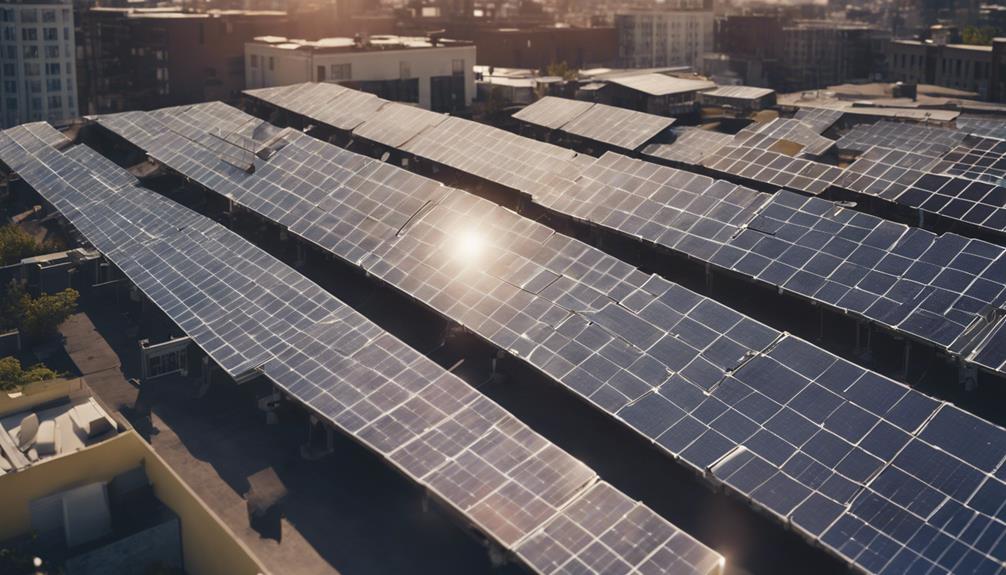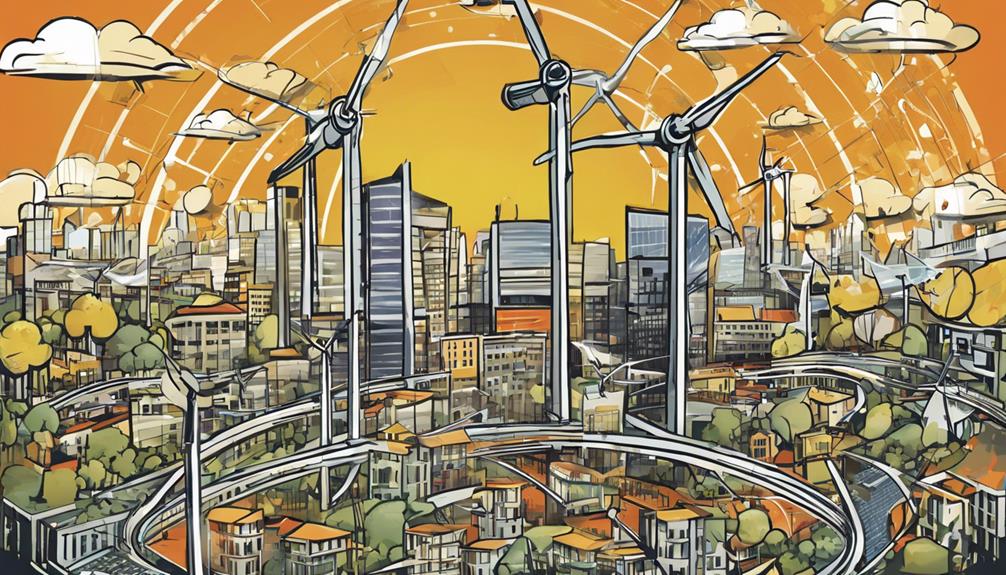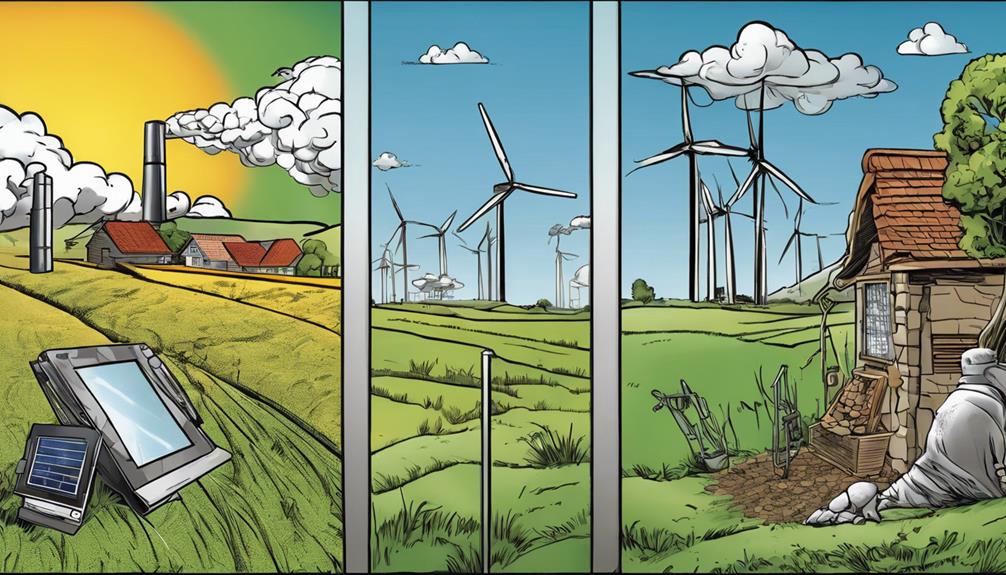When we invest in geothermal energy, we need to grasp the initial cost factors that can make or break a project. We've got to contemplate the intricate interplay of location, system components, government incentives, and technological advancements that impact the bottom line. Location and geological factors, such as resource depth and proximity to infrastructure, influence investment costs. System components, such as heat pumps and drilling costs, contribute to the expense. Government incentives can lower costs, while technological advancements enhance efficiency. As we explore these factors, we'll reveal the key to unleashing geothermal energy's potential. Let's delve deeper into the specifics that can make our investment a success.
Key Takeaways
- Location and geological factors significantly impact initial investment costs, with resources near existing infrastructure being less expensive to develop.
- Initial investment costs include the heat pump, ground loop, and distribution system, with drilling costs varying with well depth and complexity.
- Government incentives, such as grants, tax credits, and loan guarantees, can reduce initial investment costs and stimulate clean energy development.
- The cost of drilling and well construction is affected by factors like well depth, complexity, and geological characteristics of the resource.
- Understanding the initial investment costs and payback period is crucial for investors to navigate the financial landscape and make informed decisions.
Location and Geological Factors

How do location and geological factors impact the cost of geothermal energy investment, and what're the key considerations for investors and developers?
We've found that the location of the geothermal resource significantly affects investment costs. For instance, resources situated near existing infrastructure, such as roads and transmission lines, are generally less expensive to develop. On the other hand, remote locations require additional investment in transportation and distribution infrastructure.
Geological factors, like the depth and complexity of the resource, also play a vital role. Drilling and installation costs vary greatly depending on the well's depth and complexity. Understanding these factors is essential for investors and developers to accurately estimate project costs and mitigate potential risks.
System Components and Costs

We break down the initial investment costs of a geothermal energy system into three main components: the heat pump, ground loop system, and distribution system, each with its unique set of expenses.
Drilling and installation costs vary with well depth and complexity, while maintenance costs, inspections, repairs, and replacements contribute to system expenses. Installation expenses include drilling costs, equipment costs, and labor costs.
The geothermal heat pump plays a pivotal role in transferring heat to buildings, making it an essential component. Understanding these cost factors is critical for investors, as they directly impact the overall viability of a geothermal energy project.
Government Incentives and Support

Government grants, tax credits, and loan guarantees greatly reduce the initial investment costs of geothermal energy projects, making them more attractive to investors. As we navigate the world of geothermal energy investment, grasping the role of government incentives in supporting these projects is crucial. These incentives not only reduce the financial burden but also stimulate the development of clean and renewable energy sources.
| Incentive Type | Description |
|---|---|
| Federal Grants | Funding for research and development, exploration, and installation |
| State and Local Incentives | Tax credits, rebates, and property tax exemptions |
| Loan Guarantees | Government-backed loans for project financing |
Cost-Effectiveness and Environment

As we transition to a more sustainable energy landscape, geothermal energy systems offer a convincing cost-benefit proposition, combining long-term savings with a significantly decreased environmental footprint.
By harnessing the earth's natural heat, geothermal systems can reduce energy consumption by up to 44% compared to traditional systems. This translates to significant cost savings over time.
Additionally, geothermal energy is a renewable and clean energy source with minimal greenhouse gas emissions, making it an appealing option for those looking to reduce their carbon footprint.
Proper reservoir management and monitoring are essential to mitigating environmental impacts. By investing in geothermal energy, we can contribute to sustainable development goals and reduce our dependence on fossil fuels.
Technological Advancements and Challenges

Ongoing innovations are continually refining geothermal energy systems, driving up efficiency, reliability, and cost-effectiveness. We're witnessing significant improvements in drilling techniques, reservoir management, and heat extraction technologies, leading to enhanced system performance.
As we explore new ways to optimize geothermal energy production, we're also addressing existing challenges. For instance, we're working to improve efficiency, monitor fluid extraction more effectively, and refine system design. Understanding heat transfer systems and implementing proper control strategies are essential for enhancing geothermal system performance.
While there are still technological hurdles to overcome, we're confident that continued innovation will expand the use of geothermal energy and help us achieve our sustainability goals.
Investment Costs and Payback Period

We're about to immerse ourselves in the financial aspects of geothermal energy systems, and an important consideration is the initial investment cost and the payback period, which can vary considerably depending on several factors.
The location, depth of the geothermal resource, and geological characteristics all impact investment costs. Transportation and distribution costs are also influenced by resource location. Additionally, regulatory barriers and complex permitting processes can affect investment costs.
A payback period analysis helps determine the time it takes to recover our initial investment. By understanding these factors, we can better navigate the financial landscape of geothermal energy projects and make informed decisions about our investments.
Regulatory Barriers and Permitting

Geothermal energy projects often face significant regulatory hurdles, including complex and time-consuming permitting processes that can drive up investment costs and delay project timelines. These barriers can be frustrating, especially when we're eager to tap into the vast potential of geothermal energy. To navigate these challenges, it's essential to understand the permitting process and the various regulatory bodies involved.
| Regulatory Barrier | Impact on Investment Costs |
|---|---|
| Complex permitting process | Delays project timelines, increases costs |
| Lack of standardization | Creates uncertainty, adds to costs |
| Multiple regulatory agencies | Increases bureaucratic red tape, costs |
Frequently Asked Questions
How Do Local Community Attitudes Impact Geothermal Project Development?
We've found that local community attitudes greatly impact geothermal project development, as acceptance or resistance from residents can either facilitate or hinder project approval, permitting, and ultimately, investment decisions.
Can Geothermal Energy Systems Be Integrated With Other Renewable Sources?
We're exploring if geothermal energy systems can be integrated with other renewable sources. Yes, they can We can combine geothermal with solar, wind, or hydro power to create hybrid systems, enhancing overall energy efficiency and reducing emissions.
What Is the Average Lifespan of a Geothermal Power Plant?
We're delighted to explore the durability of geothermal power plants, discovering that they typically thrive for 25-30 years, with some stalwart systems stretching to 50 years or more, depending on meticulous maintenance and best operations.
Are Geothermal Systems Suitable for Small-Scale Residential Applications?
"We find geothermal systems suitable for small-scale residential applications, offering long-term cost savings, reduced energy consumption, and lower maintenance requirements, making them a viable option for environmentally conscious homeowners."
How Does Seismic Activity Affect Geothermal Resource Exploration and Development?
We've found that seismic activity greatly impacts geothermal resource exploration and development, as it affects reservoir quality, fluid flow, and overall system performance, making it essential to assess and mitigate these risks during project planning.
What are the Initial Cost Factors for Investing in Geothermal Energy?
Investing in geothermal energy requires considering initial cost factors. These include drilling and exploration expenses, as well as equipment and infrastructure costs for power plants. Despite the upfront investment, the long-term benefits of geothermal energy economic transformation make it a sustainable and lucrative option.
What are the initial cost factors to consider when investing in geothermal energy?
When investing in geothermal energy, the initial cost factors to consider are exploration and drilling expenses, plant construction and equipment costs, as well as potential transmission and infrastructure expenses. Despite these upfront costs, the long-term benefits of geothermal energy transformation sparks economic growth and sustainability.
What are the initial cost factors for investing in geothermal energy, and how do geological hurdles affect its utilization?
The initial cost factors for investing in geothermal energy include exploration drilling, resource assessment, and plant construction. Geological hurdles for geothermal energy, such as potential seismic activity and complex subsurface conditions, can increase costs and make utilization more challenging. However, advancements in technology are helping to overcome these obstacles.
Conclusion
As we close the lid on our geothermal journey, we're left with a treasure trove of insights. The ancient Greeks' concept of gaia, or Mother Earth, rings true – our planet's internal heat is a precious resource.
By grasping the complexities of initial cost factors, we can harness this power to fuel a sustainable future.
Now, it's time to roll up our sleeves and get to work, for the future of geothermal energy investment is ripe for the picking.










